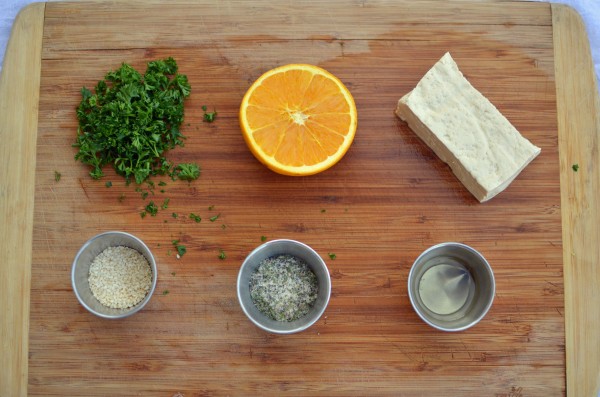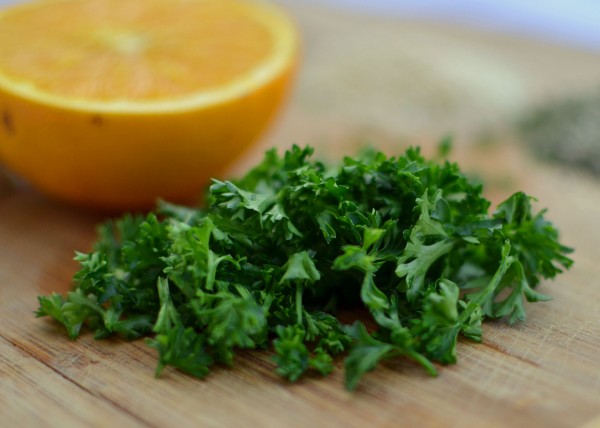I know you all want more oil-free dressing recipes (reasons why you might want to limit oil in your diet).
First, a quick introduction to parsley.
Parsley, a relative to celery, is a leafy herb used as a garnish and a flavor enhancer to many dishes, including soups, sauces, potato and rice dishes. In terms of nutrition, parsley has antimicrobial properties (which means it inhibits bacterial growth), is rich with flavonoids, in particular, apigenin, a potent anti-cancer chemical, vitamin C, K, and folate.
It is popular in Middle Eastern cuisine as well as American and European cooking, although in the later two, they tend to use parsley as a garnish (something pretty on the side), rather than something to be eaten in the dish, as is often the case in Middle Eastern dishes (think tabbouleh–this Tabbouleh recipe uses quite a bit of oil, but the tutorial is an awesome one for how to select and prepare flat-leaf parsley. Here’s an oil-free version, to make gluten free, use quinoa instead of Bulgar wheat.)
Since the flat-leaf (ie. Italian) has a stronger flavor which holds up better in cooking, I use flat-leaf parsley in many of my soups and reserve the curly stuff mostly for dressings or as garnish. I’ve even been known to throw it into a green smoothie now and again, but note, I think it only works in a smoothie in combination with things like apples, celery, and carrots rather than bananas and berries, but that’s just my take.
Flat-leaf parsley is also easier to cultivate than the curly variety, because it’s more tolerant to rain and sun, so consider adding it to your garden this year.
On to the recipe.
Creamy Parsley Dressing
GF, SF (if you use cashews)
Makes about a cup, or 8 servings
To get a creamy, oil-free dressing, instead of dairy and oil you can use tofu or some variety of nuts or seeds (vinaigrette dressings are a different story, and will be featured in a different post). A nicely blended dressing is paramount (no one wants lumps of tofu in their dressing!). I use my Blendtec and blend go through 1-2 cycles on the dressings setting.
I use the juice of 1 1/2 oranges in this recipe which gives the dressing a subtle orange flavor, but is not the dominant theme. If you want more of an orange flavor, experiment with using more juice. Fresh juice from an orange is best, but feel free to use juice from concentrate if that’s all you have around.
Fresh parsley is the key ingredient here, so don’t skimp and use fresh, if at all possible (dried parsley is pretty much a whole other substance)! One bunch of parsley runs .50 cents to a dollar and will keep in the fridge for a week or two, if stored properly. It’s a good item to have on hand, pretty much all the time, because it’s inexpensive and it great adds to the flavor and beauty of dish.
This is what you’ll need:
- 1/3-1/2 block tofu (see notes above) OR for a soy-free version, 1/2 c. raw cashew pieces
- 2 TBS. seasoned rice vinegar (if you’re watching sodium, use regular rice vinegar and add 1/2 TBS. agave or sugar to the dressing)
- 2 TBS. raw sesame seeds
- 1 TBS. vegan ranch dressing mix
- Juice of 1 1/2-2 oranges, or 1/2 c. juice (see notes above)
- 1 T-2 TBS. water (or as needed, depending on thickness desired)
- 2 TBS. fresh chopped parsley(essentially a small handful, then chop)
Start with your parsley. Wash, dry, and chop.
Get your tofu. Use 1/3-1/2 of a block, depending on how thick and creamy you want it (use 1/3 for a dressing and 1/2 for a dip). I used firm tofu.

Gather your ingredients.

Blend all ingredients except parsley. (I did one cycle on my Blendtec on dressing setting, then added parsley and pulsed a few times). Once the dressing is smooth, add parsley and pulse a few times.
Put in a pretty glass dressing jar (I hope you have one of these, they are so nice to have around) or a mason jar with a lid. Will keep in the fridge for about 3 days.
40 calories, 2 g protein, 2 g fat, .5 g fiber, 330 mg sodium (lower the sodium content significantly by omitting the salt in the ranch dressing mix and/or using plain rice vinegar).






Comments